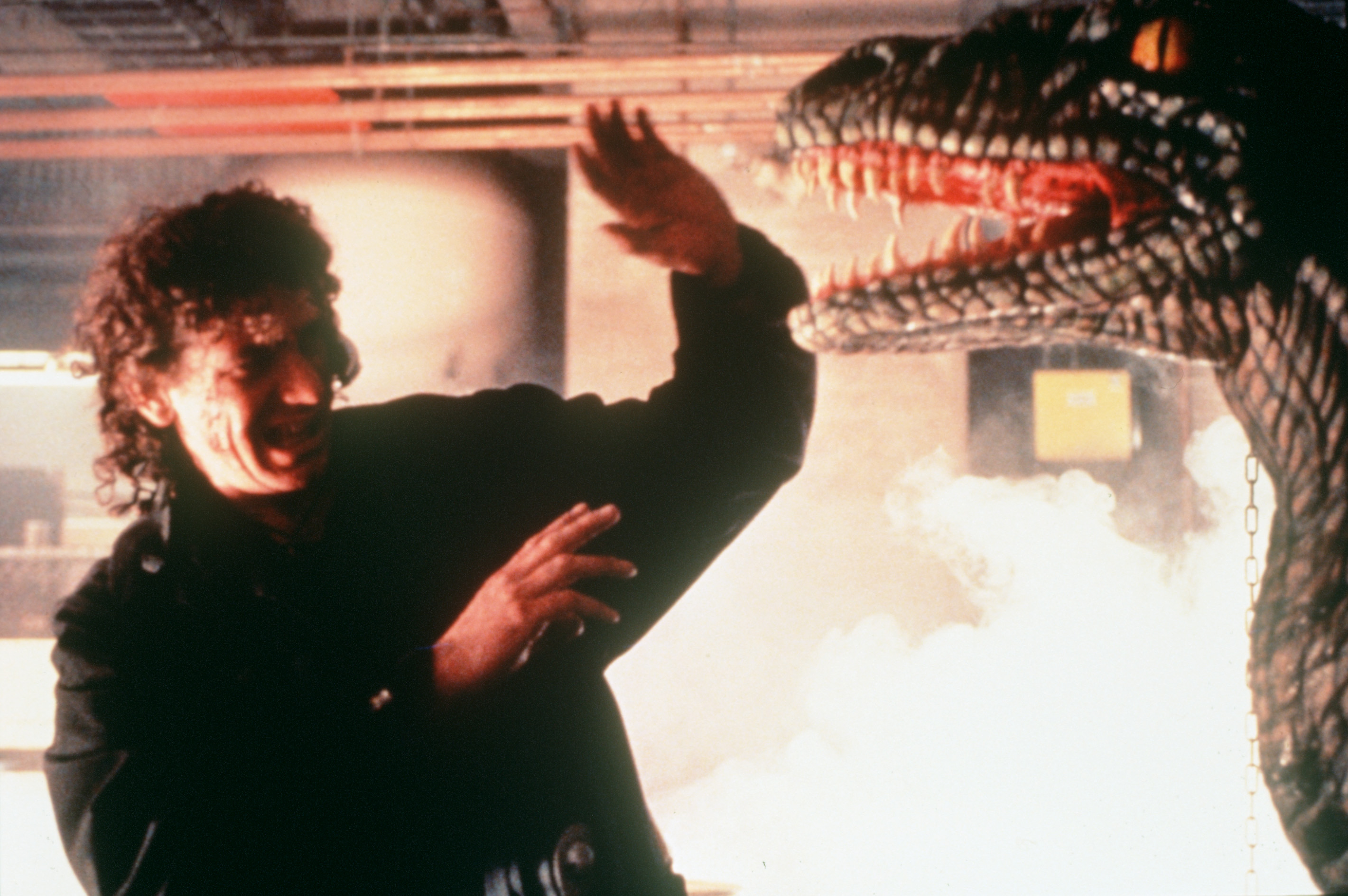Carnosaur: The hilariously dumb B-movie that rode Jurassic Park's coattails to unlikely Hollywood glory
As Jurassic World hits theaters, a look back at the other dinosaur franchise that won at the box office in the 1990s


It's hard to overstate how much Jurassic Park conquered the box office — and much of the rest of pop culture — when it stomped into theaters in 1993. The movie was a massive hit, topping the yearly box office with a gross nearly $140 million higher than its closest competitor. (A recent 3D re-release pushed it over the fabled threshold of $1 billion worldwide.)
Today, more than 22 years after the original Jurassic Park's release, the franchise continues with Jurassic World, which is expected to gross as much as $125 million over the weekend in the United States alone. If it reaches that number, it'll be the highest-grossing June release in Hollywood history.
But the success of the Jurassic Park franchise has overshadowed the other big dinosaur franchise that launched in 1993: Carnosaur. Like Jurassic Park, Carnosaur follows a person who uses cutting-edge science to bring dinosaurs back into the modern world. Like Jurassic Park, Carnosaur was loosely based on a middling sci-fi novel of the same name. And like Jurassic Park, Carnosaur was deemed successful enough to spawn two sequels. (Unfortunately, Hollywood has yet to greenlight Carnosaur World.)
The Week
Escape your echo chamber. Get the facts behind the news, plus analysis from multiple perspectives.

Sign up for The Week's Free Newsletters
From our morning news briefing to a weekly Good News Newsletter, get the best of The Week delivered directly to your inbox.
From our morning news briefing to a weekly Good News Newsletter, get the best of The Week delivered directly to your inbox.

As a film, Carnosaur was a shameless rip-off of Jurassic Park — but as a novel, Carnosaur actually beat Jurassic Park to shelves by a good six years. That doesn't mean the novel's origins were any less cynical and mercenary than the movie it spawned. "Back in 1983 a film journalist colleague of mine, Alan Jones, returned from a visit to Hollywood with the news that the next big Hollywood trend would be dinosaur movies. A whole, big line-up of dino pics were on the drawing boards, he told me," wrote author John Brosnan, who published Carnosaur under the pen name Harry Adam Knight. "So I immediately came up with a clever and cunning plan. I quickly whipped up an outline about genetically engineered dinosaurs being created in a private zoo owned by a deranged aristocrat in deepest Cambridgeshire."
Brosnan's friend turned out to be wrong about the timing of Hollywood's dinosaur craze. But when Jurassic Park arrived eight years later, Carnosaur was still ripe for the picking. The rights were snapped up by legendary schlockmeister Roger Corman, who produced the movie — on an absurdly low $1 million budget — as a direct shot across Jurassic Park's bow. Despite its obvious disadvantages, Carnosaur boldly invited comparisons to Jurassic Park in the run-up to its release. "Sixty-five million years ago they ruled the Earth. They're back, and it's no theme park!" said one of the movie's taglines. In the riskiest gamble of all, Carnosaur hit theaters just one week before Jurassic Park, riding the coattails of its rival's ad campaign. ("We were playing the old game," admitted Corman in a 1999 interview with The AV Club. "We deliberately wanted to be in there one week ahead.") Carnosaur even cast Diane Ladd, the mother of Jurassic Park star Laura Dern, in one of the leading roles.
As for the film itself: Imagine a cheaper, stupider, bloodier, crazier Jurassic Park with one really great character and a bunch of a terrible ones. Ladd steals the movie as Dr. Tiptree, a mad scientist with a lab on a chicken farm who wants to revive the dinosaurs and let them take over the planet again. Her remarkably successful method: a virus that makes women get pregnant with dinosaurs. She dies when she rips open her own pregnant stomach to ensure that the baby dinosaur within can emerge safely. (That Ladd took this role just a few years after her Oscar-nominated turn in Wild at Heart is a testament to the sheer dearth of opportunities available for older actresses.)
The dinosaurs in Carnosaur are as realistic and menacing as a T-Rex hand puppet you'd buy at a science museum — perhaps because that's basically what they were. Take a look for yourself:
A free daily email with the biggest news stories of the day – and the best features from TheWeek.com
After plenty of semi-coherent carnage, Carnosaur ends the only way it can: with the government rushing in, killing every single living character, and burning all the evidence. In a surprisingly artful final shot, a poster of MAD Magazine's Alfred E. Neumann — bearing the immortal phrase "What, me worry?" — burns above the bullet-riddled corpses of Carnosaur's protagonists. It's essentially the definition of a closed ending — so of course, Carnosaur spawned two direct sequels and two unofficial spin-offs with budgets so low that they actually reused the terrible kill scenes from the original Carnosaur.
You may not be shocked to hear that Carnosaur sits at a dismal 11 percent positive reviews on aggregator Rotten Tomatoes. Nevertheless, Carnosaur has its defenders — including, most infamously, Gene Siskel, who praised Ladd's Dr. Tiptree as "one of the craziest characters we've ever seen in a movie":
"She's got a very specific plan," argued Siskel in his "marginal thumbs up" review. "She hates people, and she loves dinosaurs, and thinks they should be in charge. I mean, that's fabulously loony!" (Countered Roger Ebert: "I felt that the plot got a little murky when all the women started to give birth to dinosaurs.") Siskel's reluctant, spotty praise was compressed, hilariously and inaccurately, for the Carnosaur VHS cover: "THUMBS UP… Terrific! I liked this movie."
In its limited 65-theater release, Carnosaur ultimately grossed $1.75 million to Jurassic Park's $357 million. But if David didn't beat Goliath, it didn't really matter; Carnosaur was a hit on its own microscopic scale.
As Jurassic World hits theaters, the Carnosaur series seems to have gone extinct — a victim to its own diminishing returns. "We had a giant return on Carnosaur," Roger Corman said in 2010. "We did Carnosaur 2 and Carnosaur 3, and the profits were still there, but dropping with each one. We went to Carnosaur 5, and we still had a profit, but our profit had steadily diminished. When I saw grosses on Carnosaur 5, which gave us a nice, pleasant profit, but nothing great, I said, 'That's the end of Carnosaur.'"
But even if it's gone, Carnosaur does occupy its own, strange corner of Hollywood history: the dumb, tiny dinosaur movie that was gutsy enough to go head-to-head with one of the biggest blockbusters ever produced — and take a small bite out of it.
Scott Meslow is the entertainment editor for TheWeek.com. He has written about film and television at publications including The Atlantic, POLITICO Magazine, and Vulture.
-
 Ski town strikers fight rising cost of living
Ski town strikers fight rising cost of livingThe Explainer Telluride is the latest ski resort experiencing an instructor strike
-
 ‘Space is one of the few areas of bipartisan agreement in Washington’
‘Space is one of the few areas of bipartisan agreement in Washington’Instant Opinion Opinion, comment and editorials of the day
-
 How robust is the rule of law in the US?
How robust is the rule of law in the US?In the Spotlight John Roberts says the Constitution is ‘unshaken,’ but tensions loom at the Supreme Court
